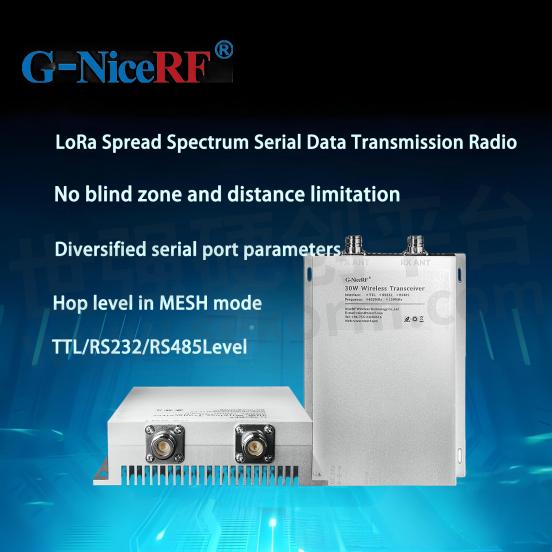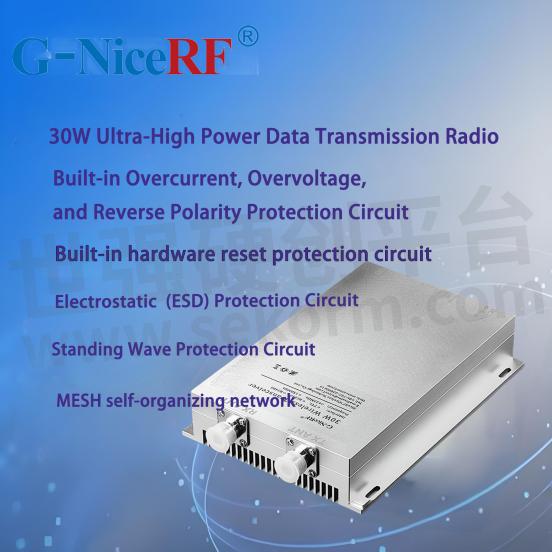LoRa Spread Spectrum Modulation Technology, Ultra-High Power Long-Distance Wireless Data Transmission Radio

The LoRaP30Pro wireless data transmission radio utilizes military-grade industrial LoRa spread spectrum modulation technology, offering long communication distances, low power consumption, and fast transmission rates. It is suitable for data transmission in fields such as industrial automation, remote wireless control, industrial data acquisition, and wireless data communication.
LoRaP30Pro is rf modem and designed for 30W output power and is available in TTL/RS232/RS485 levels. It is widely used in wireless remote transmission control.
The advantages of this digital radio station are wide voltage 9-30V, ultra-long distance, dual antennas, high-end appearance.
It has built-in hardware anti-crash self-reset circuit to resist strong external interference signals. Built-in overcurrent and overvoltage reverse connection protection circuit.
LoRaP30Pro strictly uses lead-free process for production and testing, and meets RoHS and Reach standard.
LoRa Spread Spectrum Modulation Technology: LoRa spread spectrum technology enables longer communication distances. With low transmission power density, it minimizes interference with other devices. It offers high confidentiality, making it extremely unlikely to be intercepted. The technology has strong anti-interference capabilities, effectively suppressing co-channel interference and various noises. Additionally, it enhances network efficiency and eliminates interference, allowing terminals with different spread spectrum sequences to transmit simultaneously on the same frequency without causing mutual interference.

Point-to-Point and Point-to-Multipoint Transparent Transmission Modes
Point-to-Point (P2P) transmission refers to direct data communication between two devices, suitable for long-distance transmission or scenarios where monitoring points are widely dispersed.
Point-to-Multipoint (P2MP) transmission, which is slightly more complex, experiences greater signal loss during transmission compared to point-to-point (one-to-one) transmission. Therefore, it is suitable for situations where monitoring points are more concentrated, numerous, and the transmission distance is relatively short.
Functional Features of Data Transmission Radios
The data transmission radio supports a wide voltage input range (9-30V), making it suitable for various power supply environments. It features ultra-long-distance communication capabilities and a dual-antenna design, ensuring signal stability and reliability. The module has a built-in RS485 interface with an isolation circuit, providing electrostatic protection and standing wave protection, ensuring safe operation in harsh environments. It uses a custom aluminum alloy housing to enhance durability and heat dissipation performance.
The device also features a built-in hardware watchdog reset circuit that automatically restarts the device in case of anomalies, ensuring continuous and stable operation. Additionally, it has strong anti-interference capabilities, effectively resisting external strong interference signals, further enhancing the device's reliability and stability.
Multiple protection functions, such as reverse power protection, over-connection protection, and antenna surge protection, significantly increase the radio's reliability.
Operating temperature range: -40℃ to +85℃, suitable for various harsh working environments, truly an industrial-grade product.
Powerful software features include AES128 data encryption, LBT (Listen Before Talk) function, and the ability to set parameters such as node/router/node+router options in MESH mode easily and quickly via a PC interface.

In MESH mode, the device allows users to select the hop count for data transmission. This feature optimizes network topology according to specific needs, controls transmission delay, and ensures effective data delivery in complex multi-hop networks, thereby enhancing network flexibility and reliability.
MESH self-organizing network: Developed by NiceRF, the MESH algorithm features automatic routing, forming a network transmission system with no blind spots and no distance limitations.
Precautions for Using High-Power Wireless Data Transmission Radios
Select a suitable DC regulated power supply with strong high-frequency interference resistance, low ripple, and sufficient load capacity. It is also necessary for the power supply to have overcurrent protection, overvoltage protection, and lightning protection functions.
Do not use the radio in environments that exceed its specified characteristics, such as high temperatures, high humidity, low temperatures, strong electromagnetic fields, or dusty conditions. These environments can significantly wear down the radio, shorten the lifespan of internal components, and cause substantial signal attenuation in strong electromagnetic environments, hindering wireless signal transmission.
The ground wire of the data transmission radio should be well-connected to the ground wire of external devices (such as PCs, PLCs, etc.). Otherwise, it can easily damage the communication interface or cause signal transmission instability, leading to errors and other issues.
Antenna Selection Precautions for Data Transmission Radios
To ensure optimal communication distance for the module, follow these principles during antenna usage:
Antenna Positioning: Avoid placing the antenna close to the ground surface and keep it away from obstacles.
Magnetic Base Antennas: If using a magnetic base antenna, straighten the lead wire as much as possible, and attach the base to a metal object.
Yagi Antennas: For Yagi antennas, it is recommended to place the transmitting antenna vertically and the receiving antenna horizontally.
Note: Due to the high power output, ensure the antenna is connected before the radio starts transmitting to avoid damaging the internal power amplifier module.
Antenna Distance: The distance between the receiving and transmitting antennas should be greater than 1.5 meters.
- +1 Like
- Add to Favorites
Recommend
- G-NiceRF LoRa Backscatter Device LoRa1276-C1 Provides Long-Range Communication with Low-Power
- G-NiceRF LoRa1121 Module Newly Released: Enables Multi-Band Compatibility and Satellite Communication Functionality
- G-NiceRF’s New LoRa Spread Spectrum Modulation SOC Wireless Module LoRa-STM32WLE5 with Built-in ARM and Industrial Grade Crystal Oscillator
- G-NiceRF‘s FCC Certified Products for Wireless Transceiver Module: LoRa1276-915, RF2401PRO, RF2401F20, RF4463PRO
- What Features Should a Portable Walkie-Talkie Module Have? Take G-NiceRF SA828 for An Example
- The Gas Meter Reading Application of RF Module RF4463Pro from G-NiceRF Saves Much Person Resource
- Advantages of G-NiceRF ASK Transmitter STX883Pro and ASK Receiver SRX883Pro in the Market
- What is the RSSI Function of LoRa Module
This document is provided by Sekorm Platform for VIP exclusive service. The copyright is owned by Sekorm. Without authorization, any medias, websites or individual are not allowed to reprint. When authorizing the reprint, the link of www.sekorm.com must be indicated.
























































































































































































































































































































































































































































































































































































































































































































































































































































































